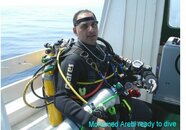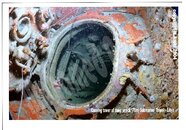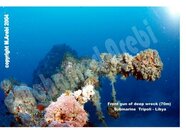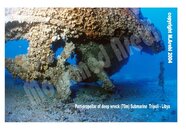You are using an out of date browser. It may not display this or other websites correctly.
You should upgrade or use an alternative browser.
You should upgrade or use an alternative browser.
New discovery of WWII HMS submarine wreck in Libya
- Thread starter arebi
- Start date
Please register or login
Welcome to ScubaBoard, the world's largest scuba diving community. Registration is not required to read the forums, but we encourage you to join. Joining has its benefits and enables you to participate in the discussions.
Benefits of registering include
- Ability to post and comment on topics and discussions.
- A Free photo gallery to share your dive photos with the world.
- You can make this box go away
A ScubaBoard Staff Message...
This is a briefly story of our discovery of the Royal Navy WWII submarine wreck HMS in Tripoli-Libya
-----------------------------------------------------
Off shore of Libyan cost and during WWII British submarines patrol our coast hunting for the German and Italian convoy supply ships.
So close to our coast no one had idea for the locations of such wrecks.
One day in April 1999 a friend fisherman loses his net, snag by something on the bottom.
I decided to explore the site , so I planed a deep dive ~ around 70 m with a support diver , for about more than hour sailing ,we started our search, but something wasn't right, there was nothing at the position that was given to us , we tried to extend the search area ,
After a longer search, a mass of red and white pixels appeared on the sounder screen, it looked like a wreck, the search had lasted about one hour until finally we threw a marker buoy over it.
We observed spots of fuel at the surface coming up from the bottom which insured that it’s a wreck.
As we attached the decompression station and spare deco bottles, I started to assemble the cylinders with the right gas mix and checked all the equipment twice.
Then we started descending into the depths, something I have done so many times before, my desire to discover the mystery , water was so clear that suddenly, the first thing that I saw was an open hatch.
It was a submarine, the wreck laid standing on its hull on the bottom little angled to port side, and the bow was totally damaged most likely by an explosion.
Large parts of the bow covered with fishing nets, and angled about 90 degrees to port side.
We examined the bow that was badly blown, swimming toward the stern the forward deck gun still standing covered with marine growth and sponge in front of the conning tower ready for action, looking from bow to stern the wreck was in perfect condition.
As I looked down through the conning tower hatch, I found the ladder still attached to the open hatch.
Over the next few dives we continued the exploration of the stern, the most impressive thing are the two propellers with the rudder.
The engine hatch was open and the ladder is still attached to the hatch as a clear evidence for the attempt to escape.
For 8 years now, myself as team leader tried to learn and work hard with the team to identify the wreck.
We proved that this wreck was Royal Navy HMS U class submarine, but no one knows which one ?
After 9th years we were able to identify the wreck as the Royal Navy HMS P32 U-class submarine.
The submarine left Malta on12 August1941for a patrol area nearTripoli Libya, On the 18 August she spotted a small Italian convoy protected by destroyers and torpedo boats heading towards the port.
The submarine rose to periscope depth to made proper position to attack. A mine, part of the minefield, exploded against her port side and flooded the forward portion of the boat forward of the control room, killing the 8 crew members in that part of the boat.
The submarine sank to the seabed. Most of the 24 survivors retired to the engine room to attempt an escape.
Coxswain Abdy, Petty Officer Kirk and ERA Martin attempted to escape using the conning tower. Martin was killed in the attempt but the other two crew survived and were picked up by an Italian ship. No other crew members survived.
Due to the belief that the escape hatch was a weak point during heavy depth charging it was fairly standard for an iron bar to be welded over the escape hatches of HM submarines on active duty.
As we found the engine hatch open and the ladder attached,
So the theory of welded iron bar over the hatch during duty needs further investigation with the official historic version.
Arebi
-----------------------------------------------------
Off shore of Libyan cost and during WWII British submarines patrol our coast hunting for the German and Italian convoy supply ships.
So close to our coast no one had idea for the locations of such wrecks.
One day in April 1999 a friend fisherman loses his net, snag by something on the bottom.
I decided to explore the site , so I planed a deep dive ~ around 70 m with a support diver , for about more than hour sailing ,we started our search, but something wasn't right, there was nothing at the position that was given to us , we tried to extend the search area ,
After a longer search, a mass of red and white pixels appeared on the sounder screen, it looked like a wreck, the search had lasted about one hour until finally we threw a marker buoy over it.
We observed spots of fuel at the surface coming up from the bottom which insured that it’s a wreck.
As we attached the decompression station and spare deco bottles, I started to assemble the cylinders with the right gas mix and checked all the equipment twice.
Then we started descending into the depths, something I have done so many times before, my desire to discover the mystery , water was so clear that suddenly, the first thing that I saw was an open hatch.
It was a submarine, the wreck laid standing on its hull on the bottom little angled to port side, and the bow was totally damaged most likely by an explosion.
Large parts of the bow covered with fishing nets, and angled about 90 degrees to port side.
We examined the bow that was badly blown, swimming toward the stern the forward deck gun still standing covered with marine growth and sponge in front of the conning tower ready for action, looking from bow to stern the wreck was in perfect condition.
As I looked down through the conning tower hatch, I found the ladder still attached to the open hatch.
Over the next few dives we continued the exploration of the stern, the most impressive thing are the two propellers with the rudder.
The engine hatch was open and the ladder is still attached to the hatch as a clear evidence for the attempt to escape.
For 8 years now, myself as team leader tried to learn and work hard with the team to identify the wreck.
We proved that this wreck was Royal Navy HMS U class submarine, but no one knows which one ?
After 9th years we were able to identify the wreck as the Royal Navy HMS P32 U-class submarine.
The submarine left Malta on12 August1941for a patrol area nearTripoli Libya, On the 18 August she spotted a small Italian convoy protected by destroyers and torpedo boats heading towards the port.
The submarine rose to periscope depth to made proper position to attack. A mine, part of the minefield, exploded against her port side and flooded the forward portion of the boat forward of the control room, killing the 8 crew members in that part of the boat.
The submarine sank to the seabed. Most of the 24 survivors retired to the engine room to attempt an escape.
Coxswain Abdy, Petty Officer Kirk and ERA Martin attempted to escape using the conning tower. Martin was killed in the attempt but the other two crew survived and were picked up by an Italian ship. No other crew members survived.
Due to the belief that the escape hatch was a weak point during heavy depth charging it was fairly standard for an iron bar to be welded over the escape hatches of HM submarines on active duty.
As we found the engine hatch open and the ladder attached,
So the theory of welded iron bar over the hatch during duty needs further investigation with the official historic version.
Arebi
Attachments
- Messages
- 3,138
- Reaction score
- 4
Very nice! Tell us more...
Very envious
This is a briefly story of our discovery of the Royal Navy WWII submarine wreck HMS in Tripoli-Libya
-----------------------------------------------------
Off shore of Libyan cost and during WWII British submarines patrol our coast hunting for the German and Italian convoy supply ships.
So close to our coast no one had idea for the locations of such wrecks.
One day in April 1999 a friend fisherman loses his net, snag by something on the bottom.
I decided to explore the site , so I planed a deep dive ~ around 70 m with a support diver , for about more than hour sailing ,we started our search, but something wasn't right, there was nothing at the position that was given to us , we tried to extend the search area ,
After a longer search, a mass of red and white pixels appeared on the sounder screen, it looked like a wreck, the search had lasted about one hour until finally we threw a marker buoy over it.
We observed spots of fuel at the surface coming up from the bottom which insured that its a wreck.
As we attached the decompression station and spare deco bottles, I started to assemble the cylinders with the right gas mix and checked all the equipment twice.
Then we started descending into the depths, something I have done so many times before, my desire to discover the mystery , water was so clear that suddenly, the first thing that I saw was an open hatch.
It was a submarine, the wreck laid standing on its hull on the bottom little angled to port side, and the bow was totally damaged most likely by an explosion.
Large parts of the bow covered with fishing nets, and angled about 90 degrees to port side.
We examined the bow that was badly blown, swimming toward the stern the forward deck gun still standing covered with marine growth and sponge in front of the conning tower ready for action, looking from bow to stern the wreck was in perfect condition.
As I looked down through the conning tower hatch, I found the ladder still attached to the open hatch.
Over the next few dives we continued the exploration of the stern, the most impressive thing are the two propellers with the rudder.
The engine hatch was open and the ladder is still attached to the hatch as a clear evidence for the attempt to escape.
For 8 years now, myself as team leader tried to learn and work hard with the team to identify the wreck.
We proved that this wreck was Royal Navy HMS U class submarine, but no one knows which one ?
After 9th years we were able to identify the wreck as the Royal Navy HMS P32 U-class submarine.
The submarine left Malta on12 August1941for a patrol area nearTripoli Libya, On the 18 August she spotted a small Italian convoy protected by destroyers and torpedo boats heading towards the port.
The submarine rose to periscope depth to made proper position to attack. A mine, part of the minefield, exploded against her port side and flooded the forward portion of the boat forward of the control room, killing the 8 crew members in that part of the boat.
The submarine sank to the seabed. Most of the 24 survivors retired to the engine room to attempt an escape.
Coxswain Abdy, Petty Officer Kirk and ERA Martin attempted to escape using the conning tower. Martin was killed in the attempt but the other two crew survived and were picked up by an Italian ship. No other crew members survived.
Due to the belief that the escape hatch was a weak point during heavy depth charging it was fairly standard for an iron bar to be welded over the escape hatches of HM submarines on active duty.
As we found the engine hatch open and the ladder attached,
So the theory of welded iron bar over the hatch during duty needs further investigation with the official historic version.
Arebi
I was very touched to read your story on this website. My father was W H Martin the submarine ERA who was lost after escaping from the conning tower of the P32. We have done some research on this for our family but never expected to see photographs of the conning tower hatch that he struggled so hard to open in his determination to escape. My mother told me that he was never a good swimmer and to reach the surface from the seabed was just too much. I was a small child at the time and so have no memory of him but my mother remained in love with him all her life until her death 10 years ago.
Thankyou Abedi for doing this research after all this time and showing us where a much loved man spent his last moments trying to get back to his beloved family.
This is always a very poignant time for us with Remembrance Sunday being this weekend and just a month away from his birthday - when he would have been 99.
I had information that people had been diving in this area from the Submarine Museum, and then contacted a local diving school to find out more.
Thank you again and may the submariners who did not escape from the ship rest in peace.
Pamela
Pamela, You did fine!
Arebi, Amazing find and thank you for giving the site the respect it and the men that perished deserve.
Arebi, Amazing find and thank you for giving the site the respect it and the men that perished deserve.
Similar threads
- Replies
- 0
- Views
- 203
- Replies
- 8
- Views
- 1,178
- Replies
- 73
- Views
- 7,144








